Abstract
At the present humanity faces many global problems connected with economic development. One of the most acute is the problem of electricity production and consumption. The article summarizes the approaches to the study of factors affecting electricity consumption, and also reveals the interdependencies in the production and consumption of energy. The regression analysis methods were used to make models and conclusions about electricity consumption in industrial regions. The authors studied the statistical data of 83 Russian regions. An econometric model showing the dependence between electricity consumption and various factors has been developed, the following factors were considered as significant: Gross regional product, industrial output, volume of construction, volume of mineral production. The research carried out in the field of electric power industry remains relevant, significant and promising. Research and development in fundamentally new energy supply technologies is caused by current crises, the increase in industrial output, the evolution of the digital society, and the growth of energy consumption. Such technologies should accelerate the transition to resource-innovative sustainable development.
Keywords: Sustainable development, crisis, energy consumption, regression analysis
Introduction
The global energy market is developing under high volatility of its prices. The growth of energy consumption was slowed in 2020. The main reasons were the fall in industrial production in most countries of the world and reduction of oil production and transportation as a result of OPEC actions and climate warming.
High rates of energy consumption growth pose both an environmental and an economic threat to society. According to Puchkov (2015) sustainable energy consumption is the basis for sustainable development of society, while any excess of energy consumption in natural processes should be regulated, and the way of such regulation in the global economy is the world crises.
The growth of total final consumption in the world for the period 1992-2018 was 2.2 times (EES EAEC…, 2021), but 2020 showed a negative increase, only in Russia the demand for electricity fell by 2.3%.
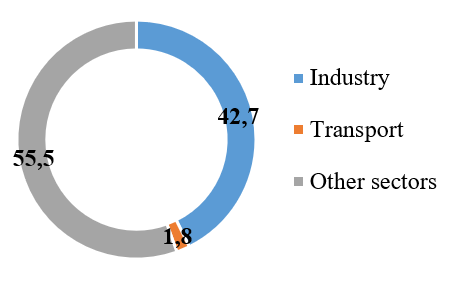
The volume of production in different regions of the world influences the energy consumption. In 2018 the share of industry in the world's energy consumption was about 42.7% (Figure 1).
The largest share of industrial production and electricity consumption is in Asia, where the share of industry is 55.1 % (Figure 2).
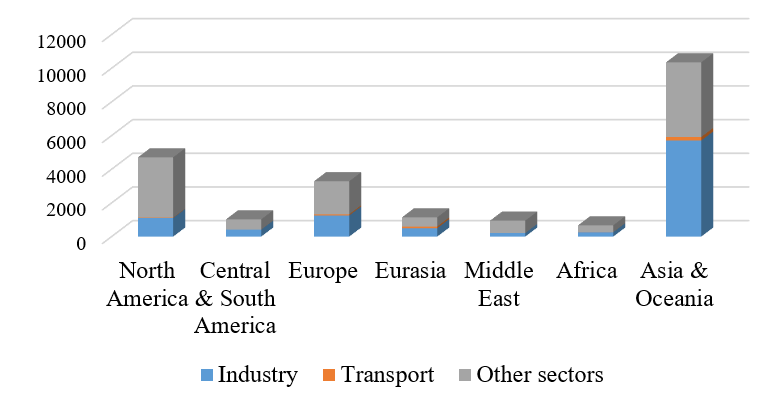
However, the GDP growth rate doesn’t directly reflect the growth rate of energy resources. The other factors, both direct and indirect, that explain the trends in the development of the energy market should also be taken into consideration.
Problem Statement
The study of energy consumption raises some theoretical and practical issues. A review of the scientific papers in the field of energy allows us to note that there is fundamental research in this field. However, the analysis of interdependent factors is not sufficiently developed. Such factors can have both direct and indirect impact on consumption and determine it in the frame of regional particularities in the long-run.
Our research covers a number of important issues:
- the use of regression analysis of electricity consumption in industrial regions, which allows us to make forecasts for the future;
- the relationship between energy consumption and global economic crises;
- the impact of energy consumption on the sustainable development of Russian regions.
Puchkov (2015), Farabi et al. (2019), Andjarwati et al. (2020) partially study the above problems, but the task of complex regression analysis taking into account regional characteristics remains unsolved.
Research Questions
In the frame of the study the following research questions were raised by the authors:
- What is the relationship between electricity consumption and production on a global scale?
- What factors affect electricity consumption?
- To what extent do certain factors affect electricity consumption in the Russian Federation?
- How does the global economic crisis affect the volume of electricity consumption?
- How do the regional features of the development of industrial regions affect energy consumption?
Purpose of the Study
Supposedly, the answers to the issues raised above will help achieve the goal and contribute to the identification of factors affecting energy consumption and the development of recommendations on balanced approach to improving the energy efficiency of the domestic economy.
Research Methods
Authors used the universal scientific research methods as well as methods for comparative, statistical, regression and econometric analysis.
At present, many researchers and state leaders are concerned about the economic growth of countries in general and several economic activities in particular. A lot of researches are carried out in both developed (such as the EU) and newly industrialized countries (China, India, Saudi Arabia, Taiwan, Malaysia, etc.), as well as in developing countries (Alarenan et al., 2020; Fernandes & Reddy, 2020).
The electricity production is one of the economic growth determinants. This factor can have a serious impact on energy consumption in industry and significantly limit gross output. This factor will negatively affect economic growth in general. In this regard, it is necessary to consider the factors that determine energy consumption and identify potential opportunities for further sustainable development.
Researchers identify the following factors that affect energy consumption: the volume of industrial production, electricity prices, the amount of fixed capital in the economy, and the population (Alshami & Sabah, 2020). Time series models, lag models, and other econometric methods are used to analyze the factors (Alarenan et al., 2020; Fernandes & Reddy, 2020). It should be noted that in recent years (before the pandemic), the growth rate of energy consumption has outstripped its production (Figure 3) (2021), International Monetary Fund, World Economic Outlook (2020), Statistical Yearbook of World Energy (2020).
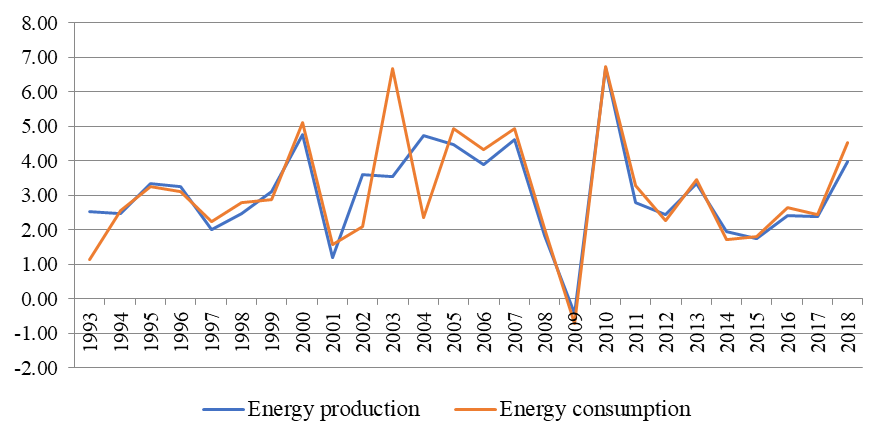
In the context of the pandemic, we should note a negative trend in world production (a decrease in world GDP by 4.4%) and a related decrease in energy consumption. At the same time, significant fluctuations in world energy prices and their recent growth (71-72 dollars per barrel in 2020) may also lead to a decrease in energy consumption (Figure 4) (Desfiandi et al., 2019; Hong et al., 2019).
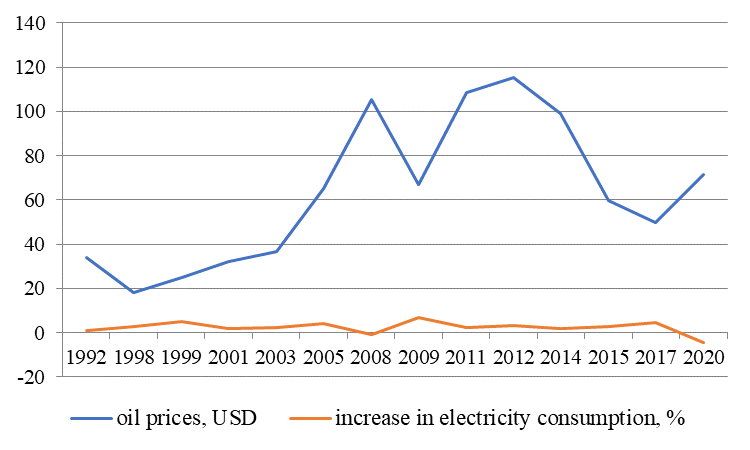
Overall, the impact of COVID-19 on global energy demand in 2020 was many times stronger than the impact of the financial crisis of 2008-2009.
In recent years, there has been a steady increase in electricity consumption, with the most significant increase in consumption recorded in Asian countries (Figure 5), which is associated with a significant increase in production in this region and in particular in China.
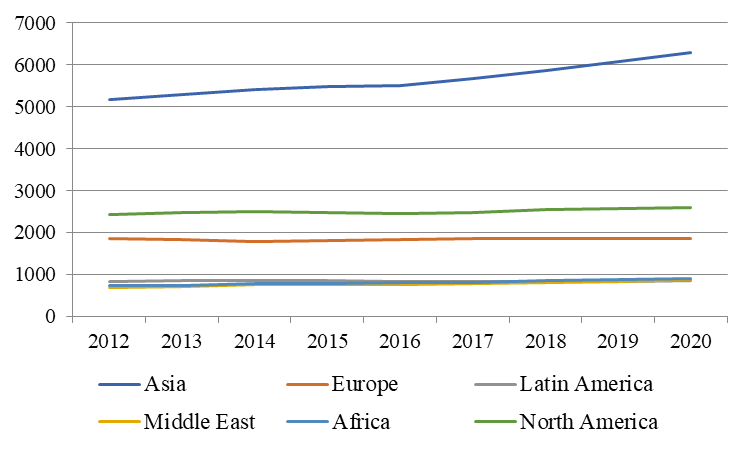
However, over the period 2011-2019, the growth rates of electricity consumption show significant fluctuations (Figure 6).
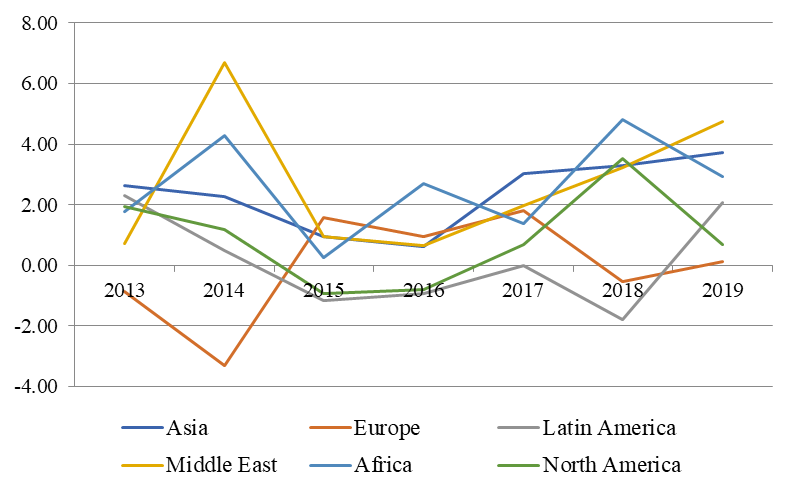
The decline in production in 2020 associated with the pandemic led to a slowdown in economic growth, but at the same time improved the environmental situation in many countries. A number of researchers have considered the issues of sustainable development from the perspective of energy consumption and energy efficiency. They established the relationship between energy consumption and economic growth, as well as the associated emissions into the atmosphere, and drew conclusions about the impact of energy consumption on the environment and the achievement of the Sustainable Development Goals (Andjarwati et al., 2020; Farabi et al., 2019). In general, it is possible to determine the necessary volumes of energy production based on the indicators of projected economic growth. However, a drop in energy consumption in 2020 may cause a slowdown in economic growth in the long run (Milovidov, 2019).
The authors studied the statistical data of 83 Russian regions. The regression analysis methods were used to make models and conclusions. Data on energy consumption were processed with the interactive regression analysis software package Building adequate approximations based on full (fractional) regular factor plans (developed by the research Institute of Mechanics of UNN) and Microsoft Excel. The following factors were chosen for the analysis; they are the gross regional product, industrial production volumes, value of assets, investments and innovation activity, mining of raw materials etc. (totally 12 factors were taking into consideration).
The authors analyzed the dependence of the factors listed above on the volume of energy consumption in regions of Russia.
Findings
The correlation analysis has shown that some variables are very strongly correlated with each other (Table 1).
Y - energy consumption by regions of the Russian Federation (data of 83 regions); X1 - Gross regional product; X2 - population; X3 - value of fixed capital, X4 - investment in fixed assets; X5 - volume of construction; X6 - volume of mineral production; X7 - industrial output; X8 - profitability of assets; X9 - innovative activity; X10 - autonomy coefficient; X11 - subsistence level; X12 - the number of patents.
The authors found out the insufficient correlation between X4, X8, X9, X11 and the resulting indicator. Also, the multicollinearity was established between X2, X3, X12. So, all these factors were excluded from the final model. The following factors were considered as significant: Gross regional product, industrial output, volume of construction, volume of mineral production.
Figures 7 and 8 show the dependence between electricity consumption, Gross regional product and volume of industrial output. Econometric models and R2 are also shown on Figures 7 and 8.
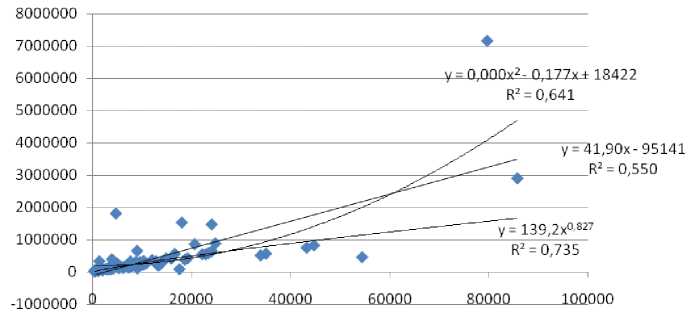
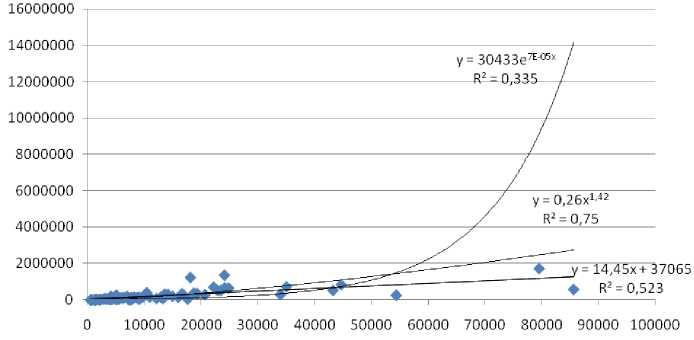
Thus, as a result of the study, we obtain a nonlinear model of multiple regression:
Y = 139.2 X10.8 +112.1 X50.6 +11X6 + 0.26X71.4 + 31.528(1)
In the frame of the research the significance of the multiple regression equation was made. To prove the significance the authors estimated the hypothesis that the coefficient of determination calculated is equal to zero: R2 or b1 = b2 =... = bm = 0 (hypothesis about the insignificance of the regression equation calculated from the General population data).
We use Fischer's F-test to check it. In this case, we calculate the actual (observed) value of the F-criterion using the coefficient of determination R2. The F critical value (Fcr) is taken from the F Distribution Tables. The Fisher criterion was calculated with the significance level α (equal to 0.05) and two numbers of degrees of freedom k1 = m and k2 = n-m-1.
(2)
The adjusted coefficient of determination estimation was calculated.
(3)
The adjusted coefficient of determination increased with new variables added to the model. The hypothesis of General significance was tested: H0:R2=0; β1= β2=…= βm=0, H1:R2≠0
This hypothesis is tested using the f-statistics of the Fischer distribution (right-hand check). If F < Fcr = F α; n-m-1, then there is no reason to reject the H0 hypothesis.
(4)
Table value for degrees of freedom k1=5 and k2 = n-m - 1 = 83 - 5 - 1 = 77. Fcr(5; 77) = 2.29.
Since the actual value of F > Fcr, the conclusion about statistical significance of coefficient R2 was made. The regression equation is considered as statistically reliable.
The econometric model received by authors is acceptable and can be used for planning energy supply. All coefficients in the model are statistically significant, and there is no multicollinearity.
Conclusion
At present the main task of long-term development is to provide the society with the necessary and sufficient energy resources. Now and in the nearest future the research carried out in the field of electric power industry remains relevant, significant and promising. The analysis of energy consumption and the identification of factors that determine the dynamics of this indicator have a strategically important role to ensure the sustainable development of the economy. According to scientists the volume of electricity consumption is primarily associated with the population and climatic conditions. In our study, we tried to reflect the influence of other important elements on the energy market, such as mining and resource depletion. This factor is very significant. In 2018-2020 the company Tesla reported about a shortage of rare earth metals for the production of batteries. In turn, the volume of production of a particular type of energy resources reflects the gross regional product.
Research and development in fundamentally new energy supply technologies is caused by current crises, the increase in industrial output, the evolution of the digital society, and the growth of energy consumption. There are such modern technologies as the conversion of carbon dioxide into fuel (Seeo2energy is already working in this direction), acoustic monitoring of the technical condition of electric motors, improvement of the kinetic fast-charging battery.
Now the Russian economy depends on raw materials and current crisis involved by pandemic influenced negatively on all spheres. The Russian Government is forced to stimulate high-tech industrial production to overcome the consequences of the crisis and raw materials dependence, and as a result to move to an innovative economy.
In the frame of the crisis the country's leadership should undertake all possibilities to accelerate the diversification of the Russian economy; the authorities should focus on the deep processing of natural resources such as gas chemistry, petrochemicals and other industries, to accelerate the transition to resource-innovative sustainable development.
Acknowledgments
The study was carried out within the framework of the basic part of the state assignment of the Ministry of Education and Science of the Russian Federation, project 0729-2020-0056 Modern methods and models for diagnosing, monitoring, preventing and overcoming crisis phenomena in the economy in the context of digitalization as a way to ensure the economic security of the Russian Federation.
References
Alarenan, S., Gasim, A. A., & Hunt, L. C. (2020). Modelling industrial energy demand in Saudi Arabia. Energy Economics, 85, 104554.
Alshami, M., & Sabah, A. (2020). The strategic importance of energy consumption to economic growth: Evidence from the UAE. International Journal of Energy Economics and Policy, 10(1), 114-119.
Andjarwati, T., Panji, N. A., Utomo, A., Susila, L. N., Respati, P. A., & Bon, A. T. (2020). Impact of Energy Consumption, and Economic Dynamics on Environmental Degradation in ASEAN. International Journal of Energy Economics and Policy, 10(5), 672.
Desfiandi, A., Singagerda, F. S., & Sanusi, A. (2019). Building an energy consumption model and sustainable economic growth in emerging countries. International Journal of Energy Economics and Policy, 9(2), 51-66. https://doi.org/
EES EAEC - information and analytical energy website. (2021). http://www.eeseaec.org/potreblenie-elektroenergii-v-regionah-i-stranah-mira (2)
Farabi, A., Abdullah, A., & Setianto, R. H. (2019). Energy consumption, carbon emissions and economic growth in Indonesia and Malaysia. International Journal of Energy Economics and Policy, 9(3), 338-345. https://doi.org/
Fernandes, K., & Reddy, Y. V. (2020). Energy consumption and economic growth in newly industrialised countries of Asia. International Journal of Energy Economics and Policy, 10(4), 384-391.
Hong, C.-Y., Yen, Y.-S., & Chien, P. (2019). Sources of economic growth and changes in energy consumption: Empirical evidence for Taiwan (2004-2016). International Journal of Energy Economics and Policy, 9(3), 346-352.
International Monetary Fund. World Economic Outlook. (2020). https://www.imf.org/en/Publications/WEO
Milovidov, V. (2019). Innovation, Sustainable Growth, and Energy: Is Leap Forward for Civilization Possible? Foresight and STI Governance, 13(1), 62-68.
Puchkov, L. A. (2015). Energeticheskii analys mirovikh krisisov [Energy analysis of world crises]. Gorny zhurnal, 4, 41-45. [in Rus.]. https://elibrary.ru/item.asp?id=24081671
Statistical Yearbook of World Energy. (2020). https://yearbook.enerdata.ru/total-energy/world-consumption-statistics.html
Copyright information

This work is licensed under a Creative Commons Attribution-NonCommercial-NoDerivatives 4.0 International License.
About this article
Publication Date
25 September 2021
Article Doi
eBook ISBN
978-1-80296-115-7
Publisher
European Publisher
Volume
116
Print ISBN (optional)
-
Edition Number
1st Edition
Pages
1-2895
Subjects
Economics, social trends, sustainability, modern society, behavioural sciences, education
Cite this article as:
Letiagina, E., Vinogradova, A., & Grinevich, J. (2021). Electricity Consumption In World Regions And Countries Under Macroeconomic Instability. In I. V. Kovalev, A. A. Voroshilova, & A. S. Budagov (Eds.), Economic and Social Trends for Sustainability of Modern Society (ICEST-II 2021), vol 116. European Proceedings of Social and Behavioural Sciences (pp. 697-706). European Publisher. https://doi.org/10.15405/epsbs.2021.09.02.78

